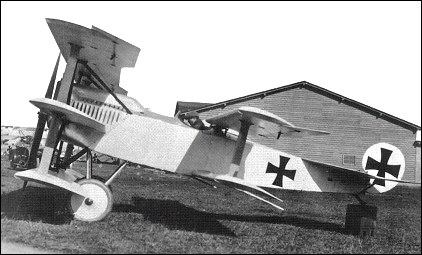|
| The Fokker V.8, which is one of those few aircraft that fall into the
category of quintrupriplane, is mainly remarkable in appearing months
after the successful V.6, prototype for the famous Dr.1 Triplane. The V.8
resembled the V.6 in some respects, but had an inline engine and three wings
at the front and two at the back. In October 1917 it was test flown by
Anthony Fokker himself, bur by all accounts this was little more than a hop.
It was apparent that modifications were needed, which were duly carried out,
and two weeks later another short flight was made. This was to be the V.8's
last and it was scrapped soon afterwards. One almost thinks it was created on
a bet, to prove that five wings were no better than three. FACTS AND FIGURES © The forward wings were mounted about
as far forward as physically possible, and
unlike the Dr.1's were not staggered. © The tail surfaces were conventional
for the time, being essentially the
same as those on the Dr.1, having
a large tailplane with elevators but
a single moveable fin surface. © The middle wings were affixed to
the top and bottom of the fuselage
just behind the pilots cockpit. All
the top wings had ailerons.
| CREW | 1 |
| ENGINE | 1 x 120hp Mercedes DIII engine |
| leo rudnicki, e-mail, 09.04.2009 03:25 Don't sweat the typing, Ed. tell me more. The Fokker archives were written by Fokker so he and his ego must know. I've always wondered who really designed the interrupter gear. Also missing from the list is the EV /DVIII. There were a couple neat monoplanes, V25 & V27, a low wing with rotary power & a mid-wing with Mercedes. reply | | geoff, e-mail, 20.08.2008 14:52 Tim is CORRECT.Records from the German town of Schwerin show Platz as a "Fleugzeigmonteur*-aircraft mechanic, from 1914-1919.German records are notable for accuracy.No drawings surviving from the era bear the name of Platz or Fokker as signing off designer.Platz was an able welder, having been taught his craft by Fouche, the inventor? of the oxy-acetylene torch.The Chief Designer of the (later)DVII was Moser whose position can clearly be verfied by a signature and postcard of the era.Platz was probably a production specialist in whether a particular welded arrangement was possible.There is doubt as regards the period after the death of Martin Kreutzner in 1916,however,there would without doubt have been a number of talented designers working in the design bureau if there was an interegnum.A reference to "Rosie" Head from an associate would appear to strengthen the belief that Platz knew little o0verall detail of aircraft Wehl claimed him to have designed!Quoting books is not good historical accuracy.Often they only quote from other books which have not been written with access to original sources. reply | | Edward Mate, e-mail, 31.05.2008 22:13 Tim you are out of it. JimBob and Mike are correct. The worlds formost authority on the D-VII as verified by the Berlin Archives Julius (Rosie) Head, deceised member of the Cross & Cockade was my buddy for the time before he died in a Rockford Air Show crash. He corresponded directly with Platz and verified that Mike Wuyek is absolutely correct. Platz gave information that only the designer would know. I read it. Thre is much more on "Rosey" that I could tell but I am s lousy typist and will save it. Ed reply | | JimBob Lowry, e-mail, 25.05.2008 09:54 'Aircraft in Profile', Volume 3,number 67,Decidedly states that Reinhold Platzwas the designer behind the success of Fokker's designs, There are many other sources that attest to this too. Check your history books. reply | |
| | Tim, e-mail, 08.08.2007 05:19 Not sure where you heard that from, sir, but completely incorrect.
Platz was Fokker's MECHANICAL engineer, and never designed an airframe himself. (For more info, please visit FokkerAG Archives) reply | | Michael Wuyek, e-mail, 06.07.2007 05:56 This was actually what happened when they let Anthony Fokker design an aircraft himself, instead of his chief engineer, Reinhold Platz. After this, Fokker left the designing to Platz, and stuck with fine-tuning the designs. reply |
|
Do you have any comments?
|
| 
COMPANY
PROFILE
All the World's Rotorcraft
|






